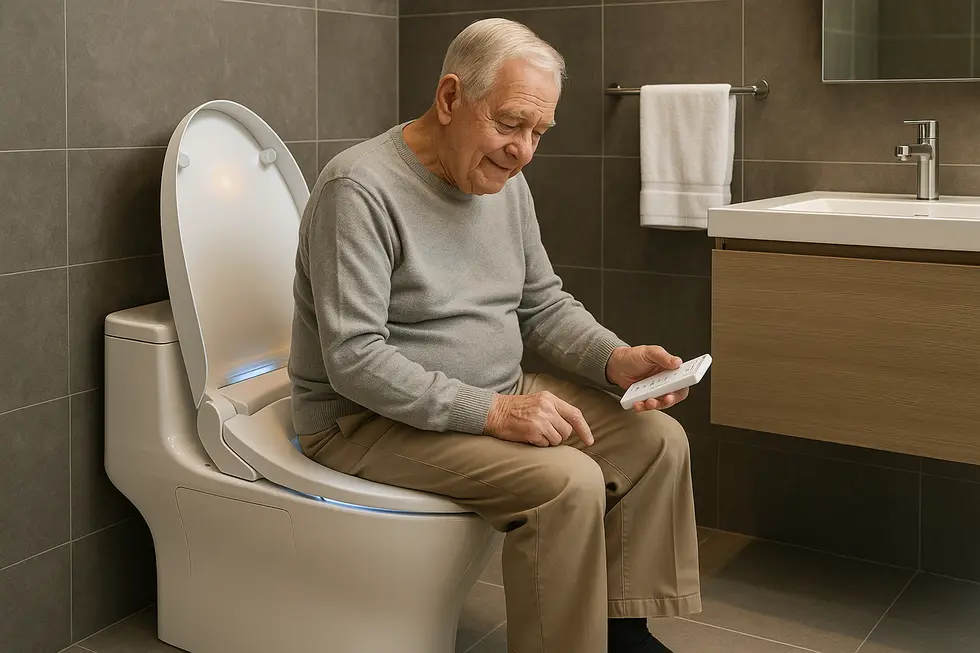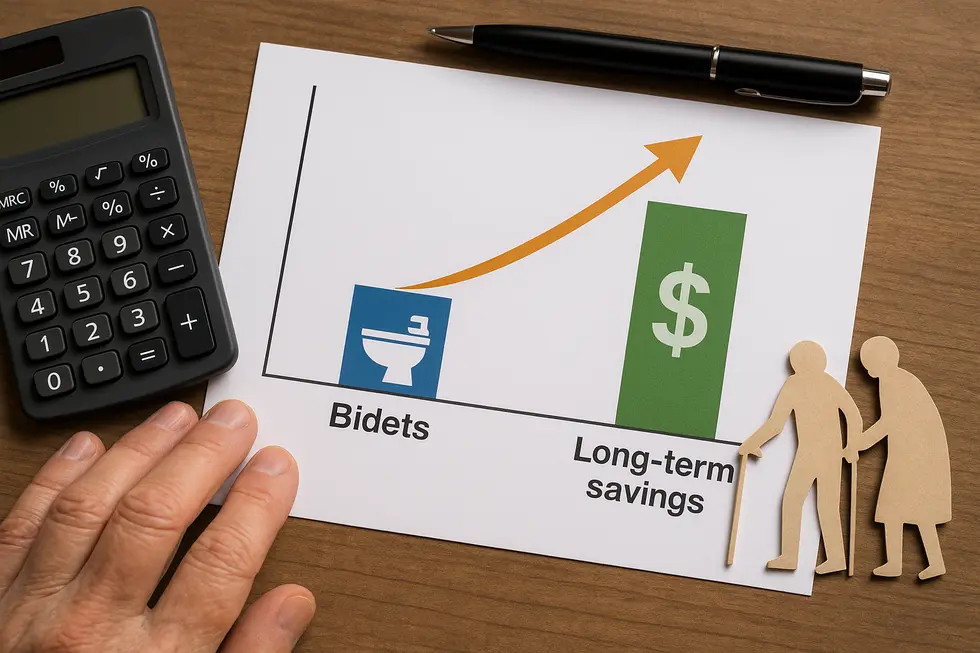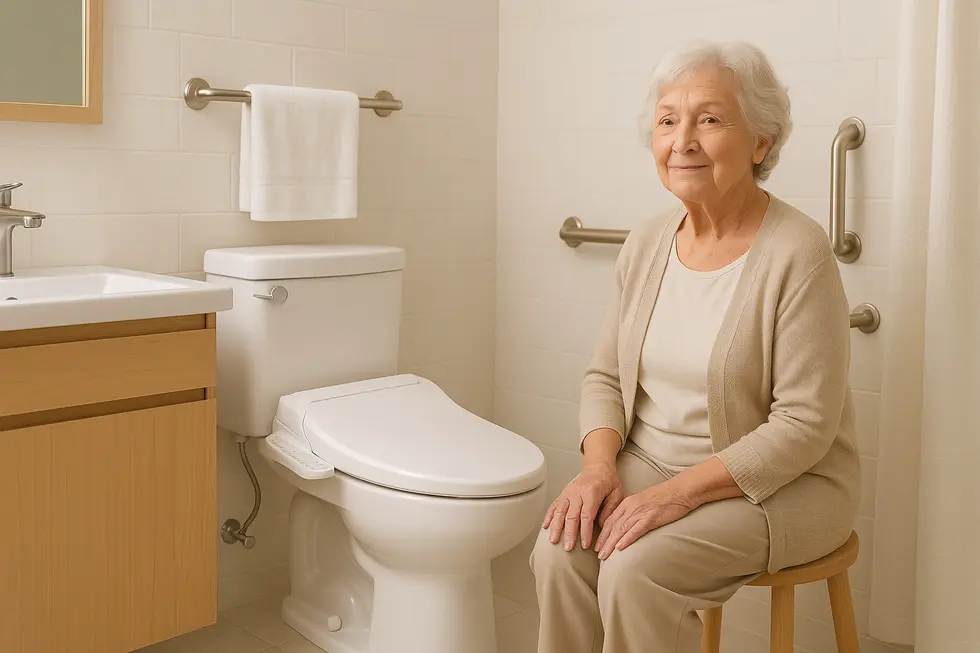Bidet Attachment
Bidets for Elderly: Enhancing Comfort, Independence, and Hygiene
As individuals age, maintaining personal hygiene independently can become a challenge. Bidets present a valuable solution, offering enhanced comfort and independence for the elderly. With technological advancements making these devices more accessible and user-friendly, the bidet for elderly populations is no longer a luxury but a necessity for many seniors. This article delves into the technological innovations making bidets more adaptable for elderly users, considers the economic implications and benefits they offer, and explores the broader societal and health impacts of their adoption.
Adaptive Bidet Technology: Turning Bathrooms into Independence Zones for Older Adults

For many seniors, the bathroom is where diminishing mobility first erodes confidence. Recent bidet for elderly innovations are reversing that trend by weaving accessibility, safety, and gentle hygiene into one intuitive package. The most visible change is the seat itself. Designers now mold elevated rims directly into bidet seats, raising the sitting surface just enough to shorten the distance between standing and resting. That subtle lift, paired with slip-resistant side contours, gives arthritic knees a friendlier target and reduces the risk of falls.
Ease of control has advanced just as dramatically. Large-font remotes with tactile buttons replace cramped side panels, letting trembling hands choose water temperature, pressure, and nozzle position without twisting the torso. Memory presets save preferred settings, so each visit feels familiar even when dexterity fluctuates day to day. Some seats pre-mist the bowl before use, keeping surfaces cleaner with almost no scrubbing—a small but meaningful win for caregivers juggling multiple tasks.
Comfort features once considered luxuries are now standard. Instant ceramic heaters deliver a warm wash within seconds, and air dryers gently fan moisture away, eliminating the awkward reach for toilet paper. Because wiping is often painful for skin thinned by age or medications, the shift from paper to water not only improves cleanliness but also calms irritation and speeds healing of common issues like hemorrhoids. For those with sensitive skin or limited range of motion, a bidet for elderly can provide a more dignified and comfortable alternative to traditional toileting.
Developers are also looking beyond the toilet. Fold-down shower benches use marine-grade brackets that resist corrosion while supporting significant weight, creating a stable perch for anyone who tires easily while bathing. As part of a broader aging-in-place strategy, integrating a bidet for elderly into the bathroom setup ensures that hygiene remains accessible, safe, and empowering for seniors. The holistic goal is clear: craft a bathroom ecosystem where every surface invites safe, independent movement.
For households upgrading an existing commode rather than replacing it entirely, step-by-step guidance on adding a bidet to an existing toilet shows how most innovations can be installed with basic tools. Seniors thus gain tomorrow’s technology without tomorrow’s remodel costs.
Hygienic benefits ripple outward as well. By reducing toilet-paper consumption, bidets lower ongoing expenses and lighten the environmental footprint—a win that matters to retirees on fixed incomes and to grandchildren inheriting the planet.
Counting the Dollars and Sense: Why a Bidet Pays Off for Older Adults

Few bathroom upgrades spark as much debate as the bidet, yet the numbers speak clearly when an older adult is involved. Up-front, even a fully featured seat rarely costs more than several months of premium toilet paper, installation is usually a simple DIY swap, and water consumption is negligible—about an eighth of a gallon per use. The real story unfolds over time. Studies show households cut paper use by up to 75 percent after switching, a reduction that translates to roughly $30 each month for a two-person home. Add gentle cleansing that prevents skin breakdown, and the bidet quickly turns from luxury to pragmatic health aid.
Healthcare expenses form the hidden half of the equation. Seniors with arthritis, Parkinson’s, or balance limitations often need caregiver assistance for wiping. By restoring reach-free hygiene, a bidet can trim paid-aid minutes or even delay the need for daily support visits. Occupational therapists regularly highlight the device as a low-cost adaptation that protects independence—an outcome far harder to price yet invaluable for both dignity and budget.
Durability further tilts the scale. Quality non-electric attachments have few moving parts and routinely last a decade; electric seats average seven to nine years with basic maintenance. When replacement finally arrives, upgrading is simpler than repairing worn plumbing fixtures. Because the hardware is portable, renters can move it to a new residence, spreading the initial expense across many living arrangements.
Environmental economics add another layer. Lower paper demand means fewer trees felled, less transport fuel burned, and reduced strain on septic systems—all factors that keep municipal fees and household repairs in check. Choosing an energy-saving mode or a non-electric sprayer minimizes utility costs, making the ecological win a financial one as well.
For families calculating return on investment, a good starting point is the online savings calculator found in this comprehensive bidet benefits guide. Enter household size, current paper spending, and frequency of use to see payback periods that often fall below eighteen months. A similar breakdown, including comfort and health dividends, is available through Ezypeazy’s detailed cost analysis of bathroom upgrades.
Restoring Dignity and Protecting the Planet: How Bidet Adoption Transforms Elderly Health and Society

Warm-water cleansing may seem like a small upgrade, yet for older adults it can redraw the borders of daily life. By replacing abrasive toilet paper with a gentle spray, bidets immediately ease common age-related conditions such as hemorrhoids, fissures, or fragile post-surgical skin. The water’s mild pressure removes residue without rubbing, reducing inflammation and lowering the risk of infection that often follows repeated wiping. Because the process is automatic, seniors with arthritis, Parkinson’s, or limited core strength avoid the twisting motions that once required assistance; the bathroom becomes a private space again, and with it returns a sense of dignity.
That regained independence echoes far beyond the restroom. Fewer caregiving hours are needed for toileting, lightening the load on family members and professional aides. Care facilities that retrofit with bidet seats report smoother workflows and fewer skin-related nursing interventions, translating into cost savings and, more importantly, happier residents. At home, older couples discover they can continue aging in place because one partner no longer depends on the other for intimate hygiene.
Society benefits in another, less obvious way: sustainability. Manufacturing a single roll of toilet paper consumes roughly 37 gallons of water, along with trees, bleach, and energy. Studies show bidet users slash paper consumption by up to 80 percent, so even factoring in the cup or two of water used per wash, the overall footprint shrinks dramatically. Less paper means fewer clogged pipes and septic issues—expenses that often fall hardest on fixed-income retirees. For environmentally conscious seniors, the switch provides a tangible act of stewardship that aligns with lifelong values.
Finally, public restrooms that add bidet fixtures become more inclusive. Travelers who rely on water cleaning—whether due to culture, religion, or disability—no longer improvise, improving hygiene for everyone who shares the facility.
For a deeper dive into the broad advantages of wash-water technology, see this concise guide on bidet toilets benefits. A range of elder-friendly models and further comparative data are cataloged at BidetKing.
Final thoughts
Bidets offer a pivotal role in improving the quality of life for the elderly, providing them with the dignity and independence they cherish. By understanding the technological innovations, financial benefits, and broader societal impacts, families can appreciate the significant advantages these advancements bring to senior care. Embracing this change not only meets immediate hygienic needs but also enriches the overall well-being of elderly loved ones.
Experience a new standard of clean with PEGABidet—designed for comfort, safety, and independence. Join thousands who trust us to make personal care simple and dignified. Contact us contact@pegabidet.com
About us
PEGABidet is a brand owned by L.A NEXTGEN LLC, based in California. We design intuitive, hygienic, and accessible bathroom solutions that prioritize safety, dignity, and independence. Our mission is to make personal care effortless and empowering for people at every stage of life.

